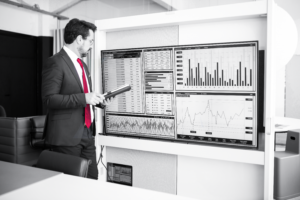Choosing the Best Data Visualization Tool for Your Teams
You have the data. Now you need to turn it into information. Perhaps you are thinking of exploring beyond what Excel can extract? And with good reason: Excel, though familiar, is bad at securely storing data, especially big data. Excel is also not easy to interact with and it’s difficult to share its visualizations. Luckily, there are a wealth of data visualization tools available nowadays, including Tableau, Power BI, Qlik, Looker, and Google’s free Data Studio.
What should you look for in a good data visualization tool? In this article, we’ll explore factors to consider when choosing the right tool for your team. We’ll talk about ease of use, analytics capabilities, customization, cost, and performance monitoring.
The Basic Data Visualization Toolkit
First, the essentials. Your data visualization tool should allow you to connect with or import data so that you can create beautiful visualizations. Make sure you can create the charts and graphs you need, whether bar charts, line graphs, scatter or geographic plots, heat maps, or something else.
Consider who will be doing the analysis and visualization. Also think of who will be looking at those visualizations. Choose a tool that is right for your team’s level of expertise. Aim for a tool that can display your data in a way that is informative, easy to understand and beautiful to people. The best plots are those in which that your data story is conveyed clearly so that it can be understood by anyone. However, you may also want specialized plots, for analysts who need to dig deeper into the effectiveness of certain models, for example.
Getting to the Details
You’ve made your first dashboard with a few plots, but now you want to drill down to the details. Make sure you select a tool that allows you to easily pivot data, filter by variables and transform data for use in plots and analysis. Decide how customizable you want your software to be.
Software with interactive graphs and dashboards, easy sharing, and publishing capabilities makes it simple to collaborate between departments or open up data to the public.
Many tools offer performance notifications and reports. These alerts can help you identify problem areas and avoid issues before they happen. For example, dashboard alerts can notify you when systems are down, when there is suspicious behavior, or when performance is particularly good or particularly bad.
Analytics
Some tools also shine in what they can do beyond data visualization. Decide on your analytics needs before selecting a data visualization tool. Can the tool handle big data? Does it need to be able to handle a lot of traffic to the site? Do you need advanced machine learning algorithms, or will simple plots and linear trends suffice?
Make sure your tool matches your product size, data and analytics needs, and growth plan.
Data Connections
Often you get the most value out of your data by combining information from multiple data sources. Look for a tool that allows you to connect with your data sources. Different tools offer options to connect to APIs, local files in various formats (e.g., JSON or flat files) and relational and non-relational database servers. Do you need a tool that can export the data too?
Other things to consider are whether you want to display live data and if it’s important to have access to your data and visualizations offline.
Cost
Consider the costs of implementation, integration with current systems, and maintenance of the new tool. Some tools are free, but have limited data connection or analytics capabilities. Some have a steep learning curve. Decide what would work best for your needs and then try a few different tools. Various tools offer education discounts and trial versions so that you can test whether they work for you. You can even take an introductory course to see how intuitive and flexible the tools really are.
Language Support
Speaking of integration costs, make sure that whatever tool you use can integrate with the languages and software tools already in use at your company. You can find a tool that offers support for a specific language, like Python, R, C, Ruby, SQL, Javascript, and other languages, and many tools support multiple languages.
Try Them Yourself!
When deciding on the best visualization tools for your team, think about who will use and maintain the tool. What tools offer the best ease of use, connectivity, analytics capabilities, scalability, customization, cost and performance monitoring for your team? No one software offers everything, but if you know what your most pressing needs are, you can find the right tools for you.
Not sure where to start? Take a Power BI bootcamp.




